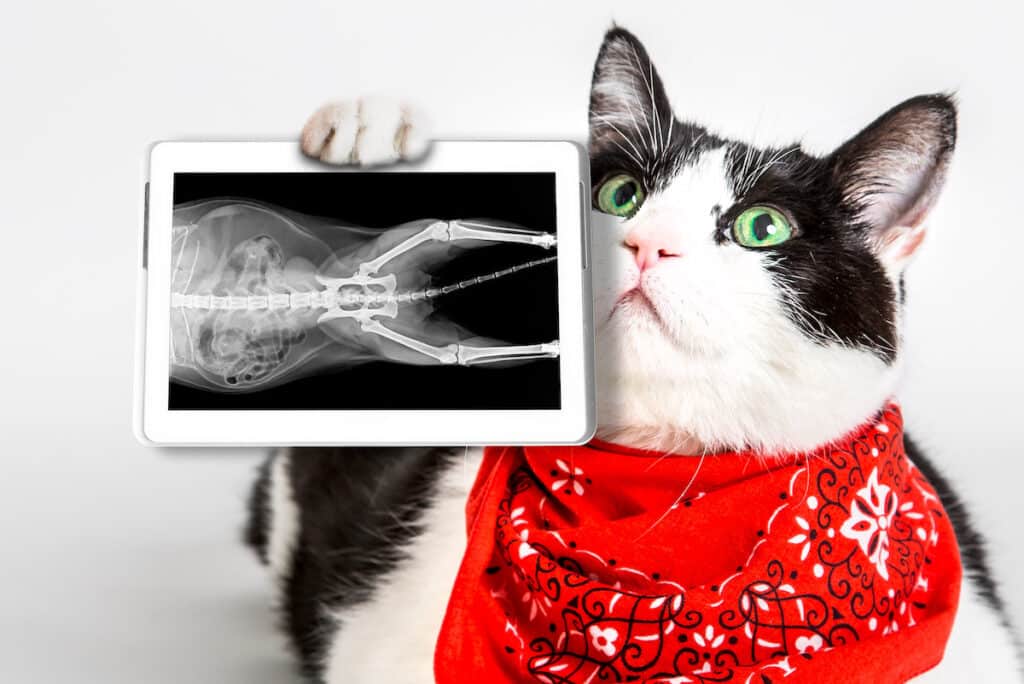One of the most popular diagnostic methods used on cats is radiography, or x-ray. The majority of veterinarians have x-ray equipment in their offices.
What Are X-Rays and How Are They Performed?
An x-ray machine uses electromagnetic radiation to create an image by passing it through a certain region of a cat’s body and onto a film. Digital x-rays, where the image is digitized rather than on a real piece of film, are now a possibility. The cat must remain motionless throughout the x-ray process, and the technicians will position her so that the x-ray beam passes across the targeted area of the body. After that, the body component is measured so the x-ray machine may be set up.
Cats can often remain awake during x-rays because the procedure doesn’t need them to hold still for very long. However, the cat could need anaesthetic if the x-ray requires that she be in a challenging position, if she hurts when being moved into position, or if she is combative.
To minimize the radiation exposure to the cat, lead aprons are typically placed over body parts that will not be subjected to x-rays. To minimize their exposure to radiation, anyone in the restraint room must wear lead aprons, gloves, glasses, and thyroid shields. On the exterior of their leads, they additionally wear monitors. In order to make sure the subject hasn’t been exposed to a lot of radiation, the monitors are periodically examined.
How Much Do Cat X-Rays Cost?
The type of x-ray required and your veterinarian will affect the cost:
- X-rays of the chest or abdomen usually range from $100 – $250.
- Dental x-rays can range from $75 to $150 to x-ray all of your cat’s teeth.
How Long Do Cat X-Rays Take?
Cat x-rays are static images, therefore the procedure typically takes 10-15 minutes rather than a procedure like an MRI.

What Are X-Rays Used for in Cats?
Here is a list of the cat body parts that get x-rayed the most frequently.
- Thorax (chest): to assess heart issues, fractured ribs, broken bones, fluid in the chest cavity, tumors, and respiratory disorders such asthma, bronchitis, and pneumonia.
- Abdomen (belly): to check for issues with the kidneys, liver, intestines, bladder, and uterus, as well as the other organs and space in the abdomen.
- Extremities: to look at the joints and bones.
- Teeth: Dental x-rays are taken using a specialized machine that can look at the tooth roots and any other problems that can develop below the gum line, where a lot of disease can hide.
A dye study may be conducted occasionally to help with visibility and identification of specific disorders. When a pet is given barium orally and subsequent abdominal x-rays are taken in order to monitor the barium’s passage through the intestinal tract, this is one common scenario in which dye is utilized for plain x-ray examinations. This can aid in the diagnosis of complete or partial blockages of the intestines.
What Are the Drawbacks of Feline X-Rays?
In general, x-rays can offer a wealth of information about a variety of illnesses. It is a relatively safe non-invasive technique. When done seldom, the little amounts of radiation required to obtain the photographs are not regarded as hazardous. If anesthesia is required to obtain high-quality photos, there may be risks involved. If dye is applied, there is a chance that someone could develop a dye allergy.
X-rays alone cannot diagnose certain conditions. Small changes in organ tissue, for example, won’t be visible on x-rays. Additionally, occasionally a problem can be seen, but there are many possible causes for the tissue to seem that way. For instance, an x-ray may reveal fluid in the chest cavity, but additional testing will be required to identify the fluid and its cause.
Therefore, to obtain additional data and make a diagnosis, x-rays may occasionally be followed by other testing such as fine needle aspiration, MRI, CT scan, or ultrasound. But occasionally, just an x-ray is enough, like with many bone fractures, some intestinal obstructions, and the presence of kidney or bladder stones (though the type of stone will still not be known until the stones can be removed and tested).














